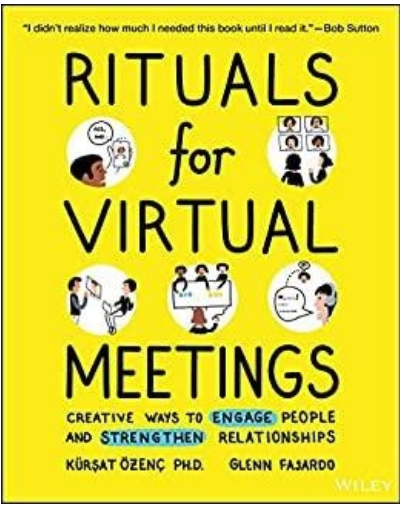Michelle Skowbo
Book Review – Rituals for Virtual Meetings, Creative Ways to Engage People by Kursat Ozenc & Glenn Fajardo (2021) Wiley

Part One: How Rituals Make Virtual Meetings More Engaging, Productive, and Meaningful
This first section consists of three focus points. The first is how rituals can transform virtual meetings. The authors discuss how relationships are developed through meetings, and through routine practices a common ground is established in the virtual space to identify meaning and connections and permits ways to address the challenges of virtual meetings. The second focus point is how meetings can be improved and nurtured by understanding the differences between in-person and virtual meetings and having awareness of the elements of meetings (i.e. goals, time, roles, words, non-verbal cues, and energy) to better interact in a virtual space. The third focus is on the fundamental keys to virtual meeting, which permit us to consider how to make the virtual interaction more human and personal, and shift how we see and approach our meetings. Throughout the section, there are examples and mini-exercises and cartoon images to support the topic of the discussion, which is delivered in a very approachable and conversational style.
Part Two: Rituals for Virtual Meetings
With its wide range of examples, Part Two presents several practical activities subdivided into six chapters. The section is rich with many practical activities to make meetings more effective. Below is a description of each of the six chapters with an example highlighted for readers.
Rituals for Beginning and Ending a Meeting with Engagement, Chapter 6, emphasizes creating a sense of community among meeting members within a safe space. Of particular interest is ritual #6, “On Purpose,” that asks participants to set their own expectations right before the beginning of a virtual gathering by writing ten words and sharing them with their peers.
Rituals for Focus, Engagement, and Flow (Chapter 7) taps into participants’ personal responsibility and commitment to the meeting and to their peers. Space perception, memory, attentiveness, but also empathy for the other, are some of the skills honed through the eight rituals presented in this chapter. Because of its very specific application to the virtual environment, “Background Together” (#7) seems worth trying as it asks participants in a virtual meeting to collaboratively create a background that represents the team’s identity.
As the authors state, Rituals for Resilience and Rejuvenation (Chapter 8) addresses “combating Zoom Fatigue.” Verve and energy drive this section that recommends physically engaging meeting members. Fascinating for its ability to instantaneously connect virtual colleagues kinesthetically is New Sensation (#2). Here, everyone is asked to put one hand into a bowl of ice water for twenty seconds to then experience theirs and their peers’ reactions.
Chapter 9 brings the reader back to activities meant for building empathy and stronger connections among partners. Rituals for Creating Connection and Building Relationships, therefore, looks for ways to humanize virtual meetings while strengthening relationships. Sharing something personal that goes beyond the known surface is the goal of “You Never Would Have Guessed” (#6) that seems particularly apt for newly formed teams. Group members are given the opportunity to think and then reveal something unknown and surprising about themselves.
Pivoting to two-person virtual meetings, Rituals for 1:1 Meetings (Chapter 10) transports us to situations that require a deeper understanding and further acknowledgment of the other to learn what might (de)motivate, help, and unite two partners. As suggested in “One Surprise” (#7) a simple question such as “what’s one surprising thing that happened to you this week?” will stimulate interest and strengthen bonds.
As the title of the final chapter suggests, Rituals for Transition and Shifting Culture (Chapter 11) features methods for dealing with change. When a new team is formed, a new project is started, or a new situation arises, we are encouraged to understand each other personally and professionally. “How we roll” (#5) is a ritual to share personal working preferences with colleagues to respond with applicable approaches as a team.
Part Three: Beyond the Office
This section focuses on rituals and guidance for teachers who are teaching and training online, again with the objective of humanizing and building connections in the virtual classroom. Like the previous section, the suggestions are presented in a lesson plan format so they are highly accessible without having to commit to extended reading. They are perfect for teachers on the go that may need to have some fresh ideas to engage learners or teachers in pre-service/in-service training.
The book is a good resource as Part One provides a conceptual framework on how to approach virtual meetings and overcome the challenges present. This lens enhances teachers’ own perspective and analysis of their meetings and class instruction. This conceptual understanding is matched with practice-based ideas presented in Part Two and Part Three, which provide activity descriptions that can be used as presented or easily adapted for teachers’ context. The suggested rituals for the most part do not require extended preparation and can directly be incorporated as practices into virtual meetings or virtual classrooms. Each ritual recommendation describes the required time for planning (e.g. on average 5-10 minutes) and the time it will take from the meeting/class time (e.g. 10-15 minutes).